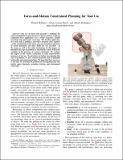Force-and-Motion Constrained Planning for Tool Use
Author(s)
Holladay, Rachel; Lozano-Perez, Tomas; Rodriguez, Alberto
DownloadAccepted version (5.977Mb)
Open Access Policy
Open Access Policy
Creative Commons Attribution-Noncommercial-Share Alike
Terms of use
Metadata
Show full item recordAbstract
© 2019 IEEE. The use of hand tools presents a challenge for robot manipulation in part because it calls for motions requiring continuous force application over a whole trajectory, usually involving large joint-angle excursions. The feasible application of a tool, such as pulling a nail with a hammer claw, requires careful coordination of the choice of grasp and joint trajectories to ensure kinematic and force limits are not exceeded - in the grasp as well as the robot mechanism. In this paper, we formulate this type of problem as choosing the values of decision variables in the presence of various constraints. We evaluate the impact of the various constraints in some representative instances of tool use. To aid others in further investigating this class of problems, we have released materials such as printable tool models and experimental data. We hope that these can serve as the basis of a benchmark problem for investigating tasks that involve many kinematic, actuation, friction, and environment constraints.
Date issued
2019Department
Massachusetts Institute of Technology. Computer Science and Artificial Intelligence Laboratory; Massachusetts Institute of Technology. Department of Mechanical EngineeringJournal
IEEE International Conference on Intelligent Robots and Systems
Publisher
Institute of Electrical and Electronics Engineers (IEEE)
Citation
Holladay, Rachel, Lozano-Perez, Tomas and Rodriguez, Alberto. 2019. "Force-and-Motion Constrained Planning for Tool Use." IEEE International Conference on Intelligent Robots and Systems.
Version: Author's final manuscript